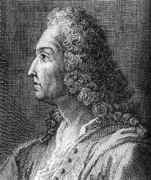Person: Bernoulli, Jacob

Jacob Bernoulli was a Swiss mathematician who was the first to use the term integral. He studied the catenary, the curve of a suspended string. He was an early user of polar coordinates and discovered the isochrone.
Mathematical Profile (Excerpt):
- Nicolaus Bernoulli was an important citizen of Basel, being a member of the town council and a magistrate.
- During the time that Jacob Bernoulli was taking his university degrees he was studying mathematics and astronomy against the wishes of his parents.
- In 1676, after taking his theology degree, Bernoulli moved to Geneva where he worked as a tutor.
- In 1681 Bernoulli travelled to the Netherlands where he met many mathematicians including Hudde.
- As a result of his travels, Bernoulli began a correspondence with many mathematicians which he carried on over many years.
- Jacob Bernoulli returned to Switzerland and taught mechanics at the University in Basel from 1683, giving a series of important lectures on the mechanics of solids and liquids.
- Bernoulli's real love was for mathematics and theoretical physics and it was in these topics that he taught and researched.
- Jacob Bernoulli also studied the work of Wallis and Barrow and through these he became interested in infinitesimal geometry.
- Jacob began publishing in the journal Acta Eruditorum which was established in Leipzig in 1682.
- It must be understood that Leibniz's publications on the calculus were very obscure to mathematicians of that time and the Bernoullis were the first to try to understand and apply Leibniz's theories.
- Although Jacob and Johann both worked on similar problems their relationship was soon to change from one of collaborators to one of rivals.
- Johann Bernoulli's boasts were the first cause of Jacob's attacks on him and Jacob wrote that Johann was his pupil whose only achievements were to repeat what his teacher had taught him.
- Jacob probably felt that Johann was the more powerful mathematician of the two and, this hurt since Jacob's nature meant that he always had to feel that he was winning praise from all sides.
- Johann would have liked the chair of mathematics at Basel which Jacob held and he certainly resented having to move to Holland in 1695.
- We shall now examine some of the major contributions made by Jacob Bernoulli at an important stage in the development of mathematics following Leibniz's work on the calculus.
- Jacob Bernoulli's first important contributions were a pamphlet on the parallels of logic and algebra published in 1685, work on probability in 1685 and geometry in 1687.
- Jacob Bernoulli published five treatises on infinite series between 1682 and 1704.
- Bernoulli also studied the exponential series which came out of examining compound interest.
- In May 1690 in a paper published in Acta Eruditorum, Jacob Bernoulli showed that the problem of determining the isochrone is equivalent to solving a first-order nonlinear differential equation.
- After finding the differential equation, Bernoulli then solved it by what we now call separation of variables.
- Jacob Bernoulli's paper of 1690 is important for the history of calculus, since the term integral appears for the first time with its integration meaning.
- proof of Bernoulli's careful and critical work on older as well as on contemporary contributions to infinitesimal mathematics and of his perseverance and analytical ability in dealing with special pertinent problems, even those of a mechanical-dynamic nature.
- Jacob Bernoulli also discovered a general method to determine evolutes of a curve as the envelope of its circles of curvature.
- The lemniscate of Bernoulli was first conceived by Jacob Bernoulli in 1694.
- Jacob Bernoulli's most original work was Ars Conjectandi published in Basel in 1713, eight years after his death.
- In the book Bernoulli reviewed work of others on probability, in particular work by van Schooten, Leibniz, and Prestet.
- The Bernoulli numbers appear in the book in a discussion of the exponential series.
- Bernoulli was one of the most significant promoters of the formal methods of higher analysis.
Born 6 January 1655, Basel, Switzerland. Died 16 August 1705, Basel, Switzerland.
View full biography at MacTutor
Tags relevant for this person:
Analysis, Astronomy, Origin Switzerland, Number Theory, Special Numbers And Numerals, Topology
Thank you to the contributors under CC BY-SA 4.0! 

- Github:
-

- non-Github:
- @J-J-O'Connor
- @E-F-Robertson
References
Adapted from other CC BY-SA 4.0 Sources:
- O’Connor, John J; Robertson, Edmund F: MacTutor History of Mathematics Archive
